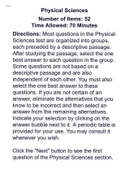Nucleophilic attacks - Study guides, Class notes & Summaries
Looking for the best study guides, study notes and summaries about Nucleophilic attacks? On this page you'll find 27 study documents about Nucleophilic attacks.
Page 2 out of 27 results
Sort by
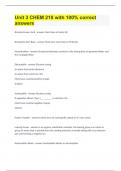
-
Unit 3 :CHEM 210 with 100% correct answers
- Exam (elaborations) • 4 pages • 2023
-
Available in package deal
-
- $13.99
- + learn more
Bronsted-Lowry Acid Must Have a Proton (H) Bronsted-Lowry Base Must have Lone Pairs or Pi Bonds Neutralization Strong Acid donates a proton to the Strong Base to generate Water and the Conjugate Base Electrophile Electron Loving An atom that wants electrons. An atom that is electron rich. Must have a partial positive charge. (Cation) Nucleophile Nucleus Loving If opposites attract, then a _________ is electron rich. Must have a partial negative charge. (An...
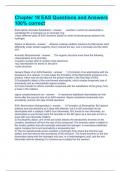
-
Chapter 18 EAS Questions and Answers 100% correct
- Exam (elaborations) • 9 pages • 2023
-
Available in package deal
-
- $12.99
- + learn more
Chapter 18 EAS Questions and Answers 100% correct Electrophilic Aromatic Substitution -reaction in which an electrophile is substituted for a hydrogen on an aromatic ring -many different types of EAS reactions based on what functional group replaces the hydrogen Alkene vs Benzene Alkenes undergo addition reactions but Benzenes react differently under similar reagents. Don't confuse the two, one is Aromatic and the other isn't. Aromatic Requirements The organic structure must...

-
UWorld: MCAT exam 2022/2023 with 100% correct answers
- Exam (elaborations) • 6 pages • 2022
-
Available in package deal
-
- $10.49
- + learn more
Mass Spectrometry (MS) used to identify the mass of molecular fragments by taking the m/z difference (technique that ionizes and fragments molecules; these ions then accelerate towards a magnet depending on their mass) Oxidation States increasing number of C-O bonds= more oxidized (oxidation state increases) increasing number of C-H bonds= more reduced (oxidation state decreases) Oxidation-Reduction (Redox) Reaction electrons are transferred from one atom to another (OIL R...
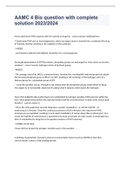
-
AAMC 4 Bio question with complete solution 2023/2024
- Exam (elaborations) • 13 pages • 2023
- Available in package deal
-
- $16.99
- + learn more
AAMC 4 Bio question with complete solution 2023/2024Most cytochrome P450 enzymes alter the activity of drugs by: - correct answer oxidizing them *Cytochrome P450 acts as monooxygenases, where an oxygen atom is inserted into a substrate (the drug of interest), thereby resulting in the oxidation of the substrate. - MISSED - was between reduced and oxidized; remember it is a monoxygenase During phosphorylation of STAT5b proteins, phosphate groups are exchanged for what atoms on tyrosine resi...
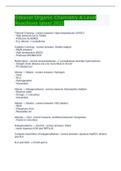
-
Edexcel Organic Chemistry A Level Reactions latest 2022
- Exam (elaborations) • 4 pages • 2022
- Available in package deal
-
- $8.49
- + learn more
Edexcel Organic Chemistry A Level Reactions latest 2022Thermal Cracking - High temperatures (1000C) - High pressure (up to 70atm) - Produces ALKENES - E.g. ethene --> polyethene Catalytic Cracking - Zeolite catalyst - Slight pressure - High temperature (450C) - Produces AROMATICS Reformation Alkanes --> cycloalkanes/ aromatic hydrocarbons - Straight chain alkanes are a lot more likely to 'knock' - Pt Catalyst (ct) Alkene → Alkane - Hydrogen - 150C - N...
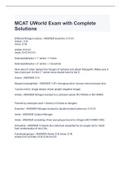
-
MCAT UWorld Exam with Complete Solutions
- Exam (elaborations) • 11 pages • 2022
- Available in package deal
-
- $10.49
- + learn more
Different Nitrogen names - ANSWER Enamine: C=C-N Amine : C-N Imine: C=N Amide: O=C-N Imide: O=C-N-C=O Ketone(aldehyde) + 1° amine --> Imine Ketone(aldehyde) + 2° amine ---> Enamine think about it when replace the Oxygen of carbonyl and attach NitrogenR, /Make sure It has a lone pair. for the 2 ° amine move double bond to the C. Amine - ANSWER C-N Myopia (nearsighted) - ANSWER *(-)F= diverging mirror /convex mirror/concave lens *convex mirror: image always virtual...
MCAT 101 EXAM 2 STUDY GUIDE 1. Explanation: This is an Analogy question. A: No. ...
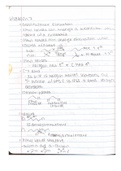
-
Substitution/Elimination Reactions--Ch 7
- Class notes • 24 pages • 2022
- Available in package deal
-
- $12.99
- + learn more
Organic Chemistry notes on substitutions and elimination, common names/naming, nucleophiles/electrophiles, leaving groups, nucleophilic substitutions, elimination reactions, SN2 reactions, nucleophilic attacks, kinetics, steric hinderance, solvent effects, E2/E1/SN2/SN1 reactions. Examples of reactions and how to tell which reaction is which. Practice problems explained.
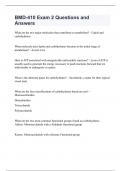
-
BMD-410 Exam 2 Questions and Answers
- Exam (elaborations) • 30 pages • 2024
-
Available in package deal
-
- $13.49
- + learn more
What are the two major molecules that contribute to metabolism? - Lipids and carbohydrates What molecule does lipids and carbohydrates become in the initial stage of metabolism? - Acetyl CoA How is ATP associated with energetically unfavorable reactions? - Lysis of ATP is usually used to generate the energy necessary to push reactions forward that are unfavorable or endergonic in nature. What is the alternate name for carbohydrates? - Saccharide, a name for their typical sweet taste ...

-
Organic Chemistry 1 Chapters 4, 5 & 6
- Class notes • 10 pages • 2023
- Available in package deal
-
- $10.49
- + learn more
Chapters 4, 5 and 6 introduce naming alkanes (single-bonded carbons) using the IUPAC system. Additionally, students learn how to distinguish between angle strain and torsional strain and how this concept relates to the amount of energy that a molecule holds. Learning about stereoisomerism is essentially to chapter 5 as this plays a role into how two similar (or different) molecules can be classified. Chapter 6 then introduces chemical reactivity and mechanisms of organic molecules. For example, ...

How did he do that? By selling his study resources on Stuvia. Try it yourself! Discover all about earning on Stuvia



